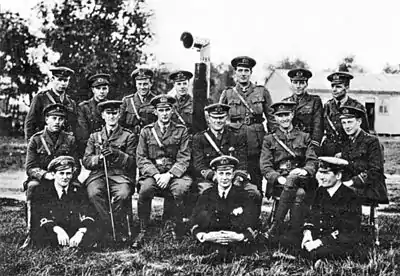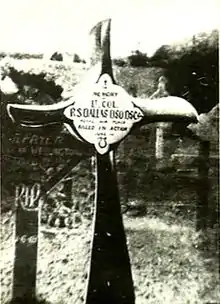No. 201 Squadron RAF
No. 201 Squadron of the Royal Air Force, until March 2010, operated the Nimrod MR2, based at RAF Kinloss, Moray. It is the only squadron affiliated with Guernsey, in the Channel Islands. This affiliation started in 1935 and is commemorated in the museum on Castle Cornet. Its history goes even further back than the RAF itself, being formed originally as No. 1 Squadron RNAS on 17 Oct 1914. The squadron will stand up again in 2021 as the second squadron equipped with the P-8A Poseidon anti-submarine warfare (ASW) aircraft.[12]
| No. 201 Squadron RAF | |
|---|---|
 | |
| Active | 17 Oct 1914 (RNAS) – 21 Jun 1915 6 Dec 1916 – 1 Apr 1918 1 Apr 1918 (RAF) – 31 Dec 1919 1 Jan 1929 – 28 Feb 1957 1 Oct 1958 – 26 May 2011 |
| Country | |
| Branch | |
| Nickname(s) | Guernsey's Own Squadron |
| Motto(s) | Latin: Hic et ubique ("Here and everywhere")[1][2] |
| Battle honours | Western Front 1915–1918* Arras*, Ypres, 1917*, Somme, 1918*, Amiens, Hindenburg Line, Channel & North Sea, 1939–1945, Norway, 1940*, Atlantic, 1941–1945*, Bismarck*, Biscay, 1941 1945, Normandy, 1944*, South Atlantic, 1982, Gulf, 1991, Iraq, 2003 Honours marked with an asterisk(*) are those emblazoned on the Squadron Standard |
| Commanders | |
| Notable commanders | Roderic Dallas Robert Marsland Groves |
| Insignia | |
| Squadron Badge heraldry | A seagull, wings elevated and addorsed[1][2] |
| Squadron codes | VQ (Apr 1939 – Sep 1939)[3][4] ZM (Sep 1939 – Aug 1943)[5][6] 1 (Nov 1943 – Mar 1944)[7] NS (Jul 1944 – Apr 1951)[8][9] A (Apr 1951 – Feb 1957)[10][11] |
History
Formation and World War I


Despite its high squadron number, 201 Squadron is one of the oldest squadrons in the RAF. It was formed as No. 1 Squadron of the Royal Naval Air Service (RNAS) on 17 October 1914, and reformed under that designation on 6 December 1916,[13] only being renumbered to 201 Squadron on the formation of the RAF on 1 April 1918 – all the RNAS squadrons getting new numbers by adding 200 to their original number.[2] It started out as a reconnaissance unit, but was soon flying fighter aircraft.
A Victoria Cross was won by a member of No. 1 Squadron RNAS when on 7 June 1915 Sub-Lieutenant R.A.J. Warneford shot down Zeppelin LZ.37.
After the war the squadron was disbanded at RAF Eastleigh on 31 December 1919.[2][13] Eighteen flying aces served in the squadron during the course of the war, including such notables as Samuel Kinkead, Stanley Wallace Rosevear, Richard Minifie, Roderic Dallas, George Gates, Reginald Brading, Maxwell Findlay, Cyril Ridley, Thomas Gerrard, John Jones, James Henry Forman, Charles Dawson Booker, Thomas Culling, future Air Vice-Marshal F. H. Maynard, Robert McLaughlin, and Hazel Wallace.[14]


Flying boat squadron
The squadron was reformed at RAF Calshot on 1 January 1929 by expanding no. 480 Flight, a Supermarine Southampton flying boat unit. In April 1936 the Southamptons gave way to the Saro London, which the squadron still had on strength when World War II broke out. Supermarine Stranraers flew shortly with the squadron in 1939, but by April 1940 the squadron was operational on the Short Sunderland, which would remain the squadron equipment for almost seventeen years up till 28 February 1957, when the squadron was disbanded at RAF Pembroke Dock.[2][13][15]
Shackletons and Nimrods
The squadron was reformed at RAF St. Mawgan, when No. 220 Squadron RAF was renumbered to 201 Squadron. The squadron flew the next twelve years with the Avro Shackleton MR.3, a version that used a tricycle undercarriage as opposed to the earlier tailwheel variants. Following the Shackleton's retirement, the squadron converted to Nimrods in October 1970.[2][13][15][16]

The squadron was active for over a decade in the Gulf region, in support of both Gulf War 1 and 2 and more recently the conflict in Afghanistan. Until March 2010, the squadron was also on active duty in the UK and maintained continuous 24-hour/365-day search and rescue standby, shared with the sister 120 Squadron, both flying from RAF Kinloss. The Nimrod MR2 was withdrawn in March 2010,[16] and the squadron was formally disbanded on 26 May 2011.[17] It had been preparing to operate the Nimrod MRA4 but this aircraft was cancelled under the 2010 Strategic Defence and Security Review.
In July 2017, it was announced that No. 201 Squadron would be one of two RAF squadrons to fly the P-8A Poseidon, based at RAF Lossiemouth.[12]
Notable squadron members
- Reginald Alexander John Warneford (Royal Naval Air Service)
- Roderic Dallas (Royal Naval Air Service)
- Richard Minifie(Royal Naval Air Service)
- John Harris (Royal Air Force), Officer Commanding 1973–75
Aircraft operated


| From | To | Aircraft | Variant |
|---|---|---|---|
| Oct 1914 | Feb 1915 | Various | |
| Dec 1916 | Jan 1917 | Nieuport 17 | |
| Dec 1916 | Dec 1917 | Sopwith Triplane | |
| Dec 1917 | Feb 1919 | Sopwith Camel | |
| Oct 1918 | Oct 1918 | Sopwith Snipe | |
| Jan 1929 | Dec 1936 | Supermarine Southampton | Mk.II |
| Apr 1936 | Jun 1938 | Saro London | Mk.I |
| Jan 1938 | Apr 1940 | Saro London | Mk.II |
| Apr 1940 | Jan 1942 | Short Sunderland | Mk.I |
| May 1941 | Mar 1944 | Short Sunderland | Mk.II |
| Jan 1942 | Jun 1945 | Short Sunderland | Mk.III |
| Feb 1945 | Feb 1957 | Short Sunderland | Mk.V |
| Mar 1946 | Apr 1946 | Short Seaford | Mk.I |
| Oct 1958 | Dec 1970 | Avro Shackleton | MR.3 |
| Oct 1970 | Feb 1983 | Hawker-Siddeley Nimrod | MR.1 |
| Jan 1982 | Mar 2010 | BAe Nimrod | MR.2 |
Squadron bases
_Squadron_Museum_(2014).jpg.webp)
| From | To | Base |
|---|---|---|
| 6 Dec 1916 | 15 Feb 1917 | Furnes, Belgium |
| 15 Feb 1917 | 11 Apr 1917 | Chipilly, France |
| 11 Apr 1917 | 1 Jun 1917 | La Belle-vue, France |
| 1 Jun 1917 | 2 Nov 1917 | Bailleul, France |
| 2 Nov 1917 | 10 Dec 1917 | Middle Aerodrome |
| 10 Dec 1917 | 16 Feb 1918 | Dover, Kent |
| 16 Feb 1918 | 27 Mar 1918 | Téteghem, France |
| 27 Mar 1918 | 28 Mar 1918 | Sainte-Marie-Cappel, France |
| 28 Mar 1918 | 12 Apr 1918 | Fienvillers, France |
| 12 Apr 1918 | 20 Jul 1918 | Nœux-lès-Auxi, France |
| 20 Jul 1918 | 6 Aug 1918 | Sainte-Marie-Cappel, France |
| 6 Aug 1918 | 14 Aug 1918 | Poulainville, France |
| 14 Aug 1918 | 19 Sep 1918 | Nœux-lès-Auxi, France |
| 19 Sep 1918 | 14 Oct 1918 | Baizieux, France |
| 14 Oct 1918 | 27 Oct 1918 | Beugnâtre, France |
| 27 Oct 1918 | 22 Nov 1918 | La Targette, France |
| 22 Nov 1918 | 5 Feb 1919 | Béthencourt, France |
| 15 Feb 1919 | 2 Sep 1919 | RAF Lake Down, Wiltshire |
| 2 Sep 1919 | 31 Dec 1919 | RAF Eastleigh, Hampshire |
| 1 Jan 1929 | 29 Sep 1938 | RAF Calshot, Hampshire |
| 29 Sep 1938 | 7 Oct 1938 | RAF Invergordon, Ross and Cromarty, Scotland |
| 7 Oct 1938 | 9 Aug 1939 | RAF Calshot, Hampshire |
| 9 Aug 1939 | 6 Nov 1939 | RAF Sullom Voe, Shetland, Scotland |
| 6 Nov 1939 | 26 May 1940 | RAF Invergordon, Ross and Cromarty, Scotland |
| 26 May 1940 | 9 Oct 1941 | RAF Sullom Voe, Shetland, Scotland |
| 9 Oct 1941 | 8 Apr 1944 | Lough Erne, County Fermanagh, Northern Ireland |
| 8 Apr 1944 | 3 Nov 1944 | RAF Pembroke Dock, Pembrokeshire, Wales |
| 3 Nov 1944 | 2 Aug 1945 | RAF Castle Archdale, County Fermanagh, Northern Ireland |
| 2 Aug 1945 | 1 Apr 1946 | RAF Pembroke Dock, Pembrokeshire, Wales |
| 1 Apr 1946 | 18 Jan 1949 | RAF Calshot, Hampshire (Det. at Finkenwerder, West-Germany) |
| 18 Jan 1949 | 28 Feb 1957 | RAF Pembroke Dock, Pembrokeshire, Wales |
| 1 Oct 1958 | 1 Jul 1965 | RAF St Mawgan, Cornwall |
| 1 Jul 1965 | 26 May 2011 | RAF Kinloss, Moray, Scotland |
References
Notes
- Rawlings 1982, p. 128.
- Halley 1988, pp. 259–260.
- Bowyer and Rawlings 1979, p. 13.
- Flintham and Thomas 2003, p. 52.
- Bowyer and Rawlings 1979, p. 121.
- Flintham and Thomas 2003, p. 123.
- Flintham and Thomas 2003, p. 128.
- Bowyer and Rawlings 1979, p. 77.
- Flintham and Thomas 2003, pp. 94 and 154.
- Bowyer and Rawlings 1979, p. 126
- Flintham and Thomas 2003, p. 192.
- "Defence Secretary announces new Maritime Patrol Aircraft squadrons". UK Ministry of Defence. 13 July 2017. Retrieved 13 July 2017.
- Jefford 2001, p. 70.
- The Aerodrome Retrieved 4 March 2010.
- Rawlings 1982, p. 129.
- Hastings, David. "BAE System Nimrod: Squadron Service". Target Lock. Archived from the original on 8 July 2010. Retrieved 4 May 2010.
- "Squadron Disbandment Parade". www.raf.mod.uk. Royal Air Force. 27 May 2011. Retrieved 29 May 2011.
- Halley 1971, p. 43.
- Halley 1988, p. 260.
Bibliography
- Ashworth, Chris. Encyclopedia of Modern Royal Air Force Squadrons. Wellingborough, UK: Patrick Stevens Limited, 1989. ISBN 1-85260-013-6.
- Bowyer, Michael J.F. and John D.R. Rawlings. Squadron Codes, 1937–56. Cambridge, UK: Patrick Stephens Ltd., 1979. ISBN 0-85059-364-6.
- Flintham, Vic and Andrew Thomas. Combat Codes: A full explanation and listing of British, Commonwealth and Allied air force unit codes since 1938. Shrewsbury, Shropshire, UK: Airlife Publishing Ltd., 2003. ISBN 1-84037-281-8.
- Halley, James J. Famous Maritime Squadrons of the RAF, Volume 1. Windsor, Berkshire, UK: Hylton Lacy Publishers Ltd., 1973. ISBN 0-85064-101-2.
- Halley, James J. The Squadrons of the Royal Air Force & Commonwealth, 1918–1988. Tonbridge, Kent, UK: Air-Britain (Historians) Ltd., 1988. ISBN 0-85130-164-9.
- Jefford, C.G. RAF Squadrons, a Comprehensive Record of the Movement and Equipment of all RAF Squadrons and their Antecedents since 1912. Shrewsbury: Airlife Publishing, 2001. ISBN 1-84037-141-2.
- Lewis, Peter. Squadron Histories: R.F.C, R.N.A.S and R.A.F., 1912–59. London: Putnam, 1959.
- Rawlings, John D.R. Coastal, Support and Special Squadrons of the RAF and their Aircraft. London: Jane's Publishing Company Ltd., 1982. ISBN 0-7106-0187-5.
- Rawlings, John D.R. Fighter Squadrons of the RAF and their Aircraft. London: Macdonald and Jane's (Publishers) Ltd., 1969 (new edition 1976, reprinted 1978). ISBN 0-354-01028-X.
External links
| Wikimedia Commons has media related to No. 201 Squadron RAF. |

